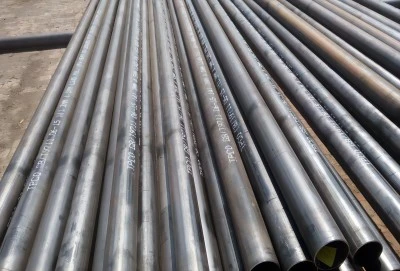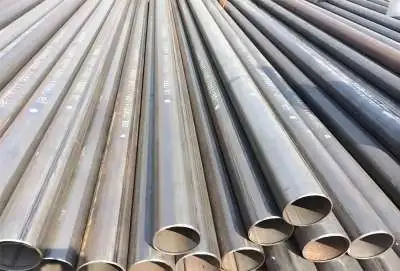Understanding the Manufacturing Process of High Frequency Welded Pipe
The production of high frequency welded pipes involves a sophisticated process that combines cutting-edge technology with precision engineering. At its core, HFW pipe manufacturing utilizes high-frequency electrical current to heat and fuse the edges of a steel strip, creating a seamless and robust weld.
The process begins with the careful selection of high-quality steel coils. These coils are then unrolled and fed into a forming machine, which gradually shapes the flat strip into a cylindrical form. As the edges of the strip approach each other, they are subjected to intense heat generated by high-frequency electrical current. This localized heating brings the edges to a near-molten state, allowing them to be pressed together under significant pressure, forming a solid and uniform weld.
One of the key advantages of HFW technology is its ability to produce pipes with consistent wall thickness and diameter. The welding process is closely monitored and controlled by advanced computer systems, ensuring optimal weld quality and dimensional accuracy. Following the welding stage, the pipes undergo a series of quality control checks, including non-destructive testing methods such as ultrasonic inspection and eddy current testing.
The efficiency of the HFW process allows for the rapid production of pipes with minimal material waste. This efficiency, combined with the high quality of the end product, makes HFW pipes an increasingly popular choice across various industries.
How High Frequency Welded Pipes Improve Structural Integrity
The structural integrity of HFW pipes is a testament to the advanced technology employed in their production. The high-frequency welding process creates a bond that is often stronger than the base material itself, resulting in pipes that exhibit exceptional strength and durability.
One of the primary factors contributing to the enhanced structural integrity of HFW pipes is the narrow heat-affected zone (HAZ) produced during welding. The localized and rapid heating and cooling cycle of the HFW process minimizes the extent of microstructural changes in the steel, preserving its original mechanical properties. This narrow HAZ translates to improved fatigue resistance and reduced susceptibility to stress corrosion cracking.
Moreover, the precision control afforded by HFW technology ensures consistent weld quality along the entire length of the pipe. This uniformity is crucial for maintaining structural integrity under various loading conditions and environmental factors. The absence of filler materials in the welding process also eliminates potential weak points that can arise from material incompatibility or incomplete fusion.
HFW pipes demonstrate superior performance in terms of pressure resistance and burst strength. The seamless nature of the weld allows for more uniform stress distribution, reducing the likelihood of failure under high-pressure conditions. This characteristic makes HFW pipes particularly suitable for applications involving the transportation of fluids and gases under pressure.
The structural benefits of HFW pipes extend beyond their mechanical properties. The smooth interior surface resulting from the welding process reduces friction and turbulence in fluid flow, leading to improved hydraulic efficiency. This feature is especially valuable in pipeline applications where energy conservation and pump efficiency are critical considerations.
Key Industries That Use High Frequency Welded Pipes
The versatility and reliability of high frequency welded pipes have led to their widespread adoption across numerous industries. Let's explore some of the key sectors where HFW pipes play a crucial role:
Oil and Gas Industry
In the oil and gas sector, HFW pipes are extensively used for the transportation of crude oil, natural gas, and refined petroleum products. The pipes' high pressure resistance and corrosion resistance make them ideal for both onshore and offshore pipeline systems. HFW pipes are also employed in well casing and tubing applications, where their structural integrity is essential for maintaining well stability and preventing leaks.
Water Management and Distribution
The water industry relies heavily on HFW pipes for the construction of municipal water supply systems and irrigation networks. The pipes' durability and resistance to corrosion ensure long-term reliability in water distribution infrastructure. Additionally, the smooth interior surface of HFW pipes contributes to efficient water flow and reduced pumping costs.
Construction and Infrastructure
In the construction sector, HFW pipes find applications in structural elements such as columns, piles, and scaffolding. Their high strength-to-weight ratio makes them an attractive choice for architects and engineers seeking to optimize building designs. HFW pipes are also used in the fabrication of steel frameworks for bridges, stadiums, and other large-scale structures.
Automotive Industry
The automotive industry utilizes HFW pipes in various components, including exhaust systems, chassis members, and structural reinforcements. The pipes' ability to withstand high temperatures and resist corrosion makes them particularly suitable for exhaust applications, where they contribute to improved vehicle performance and emissions control.
Renewable Energy Sector
As the world shifts towards sustainable energy solutions, HFW pipes are playing an increasingly important role in the renewable energy sector. They are used in the construction of wind turbine towers, where their high strength and fatigue resistance are crucial for withstanding the dynamic loads experienced by these structures. HFW pipes also find applications in solar energy installations and geothermal power plants.
Chemical and Petrochemical Industries
The chemical and petrochemical industries rely on HFW pipes for the transportation and processing of various chemicals and feedstocks. The pipes' resistance to corrosion and ability to withstand high temperatures make them suitable for use in chemical plants, refineries, and processing facilities. HFW pipes are often employed in heat exchangers, distillation columns, and other process equipment where reliability is paramount.
The wide-ranging applications of HFW pipes across these industries underscore their versatility and the trust placed in their performance. As technology continues to advance, we can expect to see even more innovative uses for HFW pipes in the future.
Advantages of HFW Pipes in Industrial Applications
The adoption of HFW pipes across various industries is driven by several key advantages:
- Cost-effectiveness: The efficient manufacturing process of HFW pipes translates to lower production costs compared to seamless pipes, making them an economical choice for large-scale projects.
- Consistency in quality: The automated nature of the HFW process ensures consistent weld quality and dimensional accuracy, reducing the likelihood of defects and improving overall reliability.
- Flexibility in production: HFW technology allows for the production of pipes in a wide range of sizes and wall thicknesses, catering to diverse industrial requirements.
- Improved material utilization: The HFW process minimizes material waste, contributing to resource efficiency and sustainability in manufacturing.
- Enhanced surface finish: The smooth interior and exterior surfaces of HFW pipes reduce friction losses in fluid transport and improve coating adhesion for corrosion protection.
Future Trends in HFW Pipe Technology
As industries continue to evolve, so does the technology behind HFW pipe manufacturing. Some emerging trends in this field include:
- Advanced materials: Research is ongoing to develop new steel alloys that can further enhance the performance of HFW pipes in extreme environments.
- Smart manufacturing: Integration of Industry 4.0 technologies, such as artificial intelligence and machine learning, is expected to optimize the HFW production process, leading to even higher quality and efficiency.
- Sustainable production: Efforts are being made to reduce the environmental footprint of HFW pipe manufacturing through energy-efficient processes and the use of recycled materials.
- Enhanced testing methods: Development of more sophisticated non-destructive testing techniques will further improve quality assurance in HFW pipe production.
The continuous advancement in HFW pipe technology promises to unlock new possibilities across industries, driving innovation and improving the efficiency of critical infrastructure projects worldwide.
Contact Longma
High frequency welded pipes represent a significant leap forward in steel pipe manufacturing technology. Their unique combination of strength, durability, and cost-effectiveness has made them an indispensable component across a wide range of industries. From oil and gas transportation to renewable energy infrastructure, HFW pipes continue to prove their worth in demanding applications.
As we look to the future, the ongoing development of HFW technology promises even greater advancements in pipe performance and manufacturing efficiency. These innovations will undoubtedly play a crucial role in shaping the infrastructure of tomorrow, driving progress across industries and contributing to a more sustainable and resilient world.
For more information about our high-quality HFW pipes and other steel pipe products, please don't hesitate to contact us at info@longma-group.com. Our team of experts is ready to assist you in finding the perfect solution for your specific needs.














